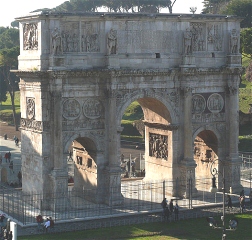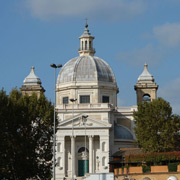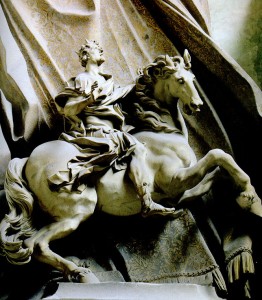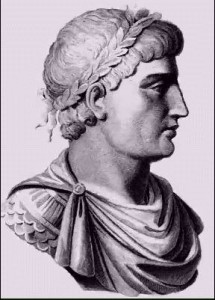Christian Revolution Under Constantine: 1700th Anniversary Series, Part 1
Part 1, Part 2, Part 3, Part 4
The air of centuries ago is healthful to inhale, especially when it blows balmy and pristine. Wafting from the past, the great Christian revolution of the 4th century has the capacity to ennoble modern hearts and uplift minds that have sunk like stones into what is seen as a macabre and machine-like world.
This year marks the 1700th anniversary of the Battle of Milvian Bridge, October 28, 312 AD, when Constantine’s army took Rome and proceeded to roll back a cruel and powerful tyranny. Shortly after this bloody battle, the Edict of Milan legalized Christianity and ended 2½ centuries of persecution. Our ancestors in the faith were officially free.
Until this blessed deliverance, imperial hostility to the Gospel was the order of the day. Oppression had been political policy, off and on, since Pontius Pilate consigned our Savior to death on a cross. Later, during the Emperor Nero’s persecution of 64-68 AD, the Apostles Peter and Paul and many others were martyred for the faith. Waves of government-sponsored persecution followed, based on what was perceived as a seditious threat to the state and its official religion. Under the Emperor Valerian, for example, Bishop Cyprian of Carthage was regularly harassed by the government; eventually he was executed as the “ringleader of an unlawful association.”
For Rome the problem was that Christians were serious about the first Commandment: “Thou shalt not have false gods before me.” It was seen as subversive when citizens renounced ritual sacrificing to the divinity of the genius of the Roman Emperor. Moreover, every time Christians broke the law which made sacrifice a legal obligation, they undermined the authority of the state by modeling civil disobedience.
The depth of alienation felt by many Christians was articulated by Speratus in 180, one of the twelve martyrs during the persecution sanctioned by the so-called “good Emperor,” Marcus Aurelius. In defiance of the Roman Empire with its vile religion, St. Speratus proclaimed “I recognize not the empire of this age.”
Loyalty to Christ and disdain for political perversity yielded plenty of civil disobedience, most of it passive refusal to obey an ungodly law. Some of the resistance was more active, like ripping down proclamations or even arson against the imperial palace in Nicomedia.[1]
For the time being there would be no recourse to the sword. It would be nearly a century before St. Augustine would consider warfare from a theological standpoint, and many more centuries before Edmund Burke would coin the phrase, “there is a point at which forbearance ceases to be a virtue.” Nonetheless a theory of justifiable insurrection and the principles of self-defense were written on the human heart, and under the pressure of persecution it took a kind of miracle to refrain from retaliating.
Another sort of miracle took place under the leadership of the great soldier and liberator, Constantine. On the heels of his military conquests in 312, his Edict of Milan (January/February, 313) arrested the persecution and brought a new measure of peace. Furthermore, the edict began the transition to political favor and cultural preeminence for the Catholic Church. The Arch of Constantine, erected in 315, still stands grandly as “a passageway from the pagan world to the Christian.”[2]
In 1913, to celebrate what was then 1600 years since the Edict of Milan, Pope Pius X ruled that this Christian Revolution warranted a jubilee throughout the Catholic world. Plans were also laid for construction of a church in Milvian Square, on the site of the battlefield.[3]
In 2012, to mark what is now 1700 years, a series of articles in Catholic Lane will celebrate the Romans who radically changed the world for the better during Constantine’s reign. Our series will also commemorate the end result of their revolution – though with caveats and qualifications related to modern sensibilities and to the principles set forth in the Establishment Clause of the US Constitution.
Still unfinished in Constantine’s day, the revolution was to make the imperial government overtly and militantly Christian. The resulting theocracy would prove to be no temporary transformation. It would endure more than 1100 years – until 1054 in the Roman Catholicism of the Eastern Roman Empire, and for another four centuries in the Greek Orthodox government of the later Byzantine Emperors (and from 1204-1461 in the Empire of the Trebizond).
In our own day the militant secularism afflicting Western Civilization presents the starkest of contrasts to what Constantine and his cohorts achieved during the 55 years of his reign and that of his sons. Above all, their revolution succeeded in liberating Christians to leaven the culture and transform Roman society spiritually. Humanity would benefit for many centuries insofar as Christendom would give more potency to charity, noble sentiments, and morality in accord with the Ten Commandments.
Today, the powerful resurgence of paganism in postmodern form, notably in North America and Western Europe, is marginalizing Judeo-Christian faith and morals. This onslaught confronts us with tough challenges, against which the strategy and tactics employed during Constantine’s time offer insightful contrasts and comparisons.
About midway through the third century, a welcome blessing came to the Church. This “Little Peace” of 42 years (261-303) was one of the longest respites from persecution up to that time. Religious freedom in the Empire had been a luxury enjoyed sporadically and tentatively by Roman Christians. Nonetheless our numbers grew, nourished by the seed-blood of the martyrs, so that at the end of the third century Christians comprised about ten percent of the population. But, alas, the “Little Peace” gave way to the Great Persecution.
Initiated in 303 during the reign of Diocletian, it was carried on for a decade with bloody and methodical determination. The political sphere was threatening a social minority with extermination, a sort of sub-cultural genocide. Some of our ancestors in the faith resisted and became martyrs. Weaker spirits bowed to the tyrants and offered the obligatory sacrifice. Still others fled like the Maccabeans to “fields and deserts, forests and mountains,”[4] or emigrated to Gothic lands north of the border.
Then things changed radically for the better. As the contemporary historian, Eusebius of Caesarea, put it, “God caused a great light to shine forth as in the midst of a dark and gloomy night, and raised up a deliverer ….”[5] Employing brilliant and daring military tactics, and marching under the banner of the cross, Constantine and his confreres took control from the Atlantic to the Adriatic.
Once in power, the revolutionaries proceeded forthwith to impose reforms by political force. In those years (as in our own era), serving Christ in the political sphere meant giving the Gospel its proper freedom and effect. By Constantine’s own testimony he was not only a political leader of revolution from the top down, but a “general bishop”[6] assisting in integrating and empowering the sector of society that had been an illegally competing power center.
The Church was well organized and had long been “a state within a state,” which a number of previous emperors had proceeded to persecute as a threat.[7] Now Constantine donned two hats, one as emperor and another as a bishop or “thirteenth apostle.” [8] Assiduously he worked to design and impose sweeping reforms that were highly favorable to Christianity. He took forceful steps “in disregard and defiance of the vast majority of his subjects.”[9]
In other words it was a risky as well as a radical venture by Constantine and by his fellow revolutionaries. Its risky character was manifested in the cautious approach to religious revolution during the twelve years after taking the city of Rome. Constantine’s “Christianizing mission” was kept somewhat under wraps.
But with his successful crusade in the Summer of 324, Constantine’s complete control of the Roman Empire was established, and his rivals routed.[10] Licinius, the persecuting Emperor of the East, was deposed, exiled, and in 325 hanged for plotting a return to power. Constantine’s government was now at liberty to take “specific actions clearly indicating that he expected Christianity henceforth to be accepted as the official religion of the Roman Empire.”
Constantine insisted on restitution of Christian property commandeered during the persecution; also he launched a massive construction project for Christian churches. Soon he would gift the Lateran palace to Pope Militiades, and begin providing state salaries for Catholic clergy. For Constantinople, his new capitol city, Constantine commissioned Bishop Eusebius of Caesarea to produce fifty Bibles.
In addition, he began raising the bar on public morality. In 325 he banned the gladiatorial games, and the following year it became illegal for a married man to have a concubine. An historian of the time describes his move against ritual sodomy:[11]
To those in Egypt and especially Alexandria, who had a custom of worshipping their river through the offices of effeminate men, another law was sent out, declaring that the whole class of homosexuals should be abolished as a thing depraved, and that it was unlawful for those infected with this gross indecency to be seen anywhere. (Eusebius Life of Constantine 4.25)
Pagan writers of the 4th and 5th century, like Julian, Annianus Marcellinus, Sextus Aurelius Victor, Zozimus and Eunapius, were no less put off by the imposition of biblical morality than are postmodern pagans today, insofar as Christians dare fight the good fight in the postmodern public square. Much of the ire of Roman pagans was focused on Constantine personally; for his reign was that of an “imperial theocrat,” backed by the bishops, pushing Christianity to preeminence within the framework of religious toleration.[12] In the process Constantine would necessarily offend non-Christians by undermining the traditional preferment enjoyed for centuries by cults associated with the Olympian gods.
Historians like Edward Gibbon accuse Constantine of personal ambition, but his overriding driving ambition “was to integrate the Church so thoroughly into the life of the empire that no persecution would ever occur again.” Constantine believed that he had a duty to use his power to protect the Church,” and also, as Constantine himself put it, to “’drive the dragon out of the administration of public affairs.’”[13]
Throughout Constantine’s three decades’ reign, pagans retained a considerable degree of religious freedom, as the French scholar and unbeliever, Paul Veyne concedes.[14] To justify his policy of toleration, Constantine issued his “Edict on Religion” in the spring of 325, shortly before the Council of Nicaea. Here are some notable words issued by the Emperor himself:
[I]t is one thing voluntarily to undertake the contest for immortality (for eternal salvation), another to compel others to do so from fear of punishment.[15]
In his The Christianity of Constantine the Great (1996, p. 366), Thomas G. Elliott – the late professor of classics at the University of Toronto – indicates that in his role as “general bishop,” Constantine “had a light touch” in dealings with the Church. Norman Baynes (The Byzantine Empire, 1925, p. 17) thinks that Constantine’s real glory was his invention of toleration, and persistence in it, in an age which had no understanding of religious toleration.
Unlike the postmodern idolatry toward tolerance, however, Constantine “did not love toleration for its own sake: he regarded it as a means to peace.”[16] Especially after the great sign in the sky under which his Italian campaign prospered, his religiosity became more fervent and he never idolized inclusiveness. Constantine worshiped exclusively at the altar of the Holy Trinity, opposed the heresy of Arianism, and looked askance at theological diversity within the ranks of the Church.
Constantine’s ambivalent tolerance for pagans outside the Church was, however, a cause for apprehension from the Christians’ standpoint. So long as paganism continued to exercise a significant influence in Rome, it was an old enemy poised to revive – like Carthage bedeviling Cato the Elder centuries before. Certainly the Christians had no cause for complacency. Even a return to the days when believers were delivered to the lions was not far-fetched.
Indeed, less than a decade after the Milvian Bridge, the persecutions revived for about four years under Licinius in the eastern half of the Empire. It took an “apocalyptic crusade” to put the imperial persecutor down. This aforementioned civil war of 324 was far more than rivalry for power between Constantine and Licinius; it was a religious struggle, or holy war, fought to defend Christianity’s recent liberation.[17] Suppose in that closely fought conflict the “mad” persecutor, Licinius, had been victorious? Or what if Constantine had died of the thigh wound inflicted by Licinius’ forces on July 3rd, during the Battle of Hadrianople?
Constantine was mortal, as everyone knew, and counterrevolution might yield pagan dominance and renewed repression of Christianity. And so with Christian advisors (possibly including some inherited from his father’s court), and with other confidants (likely including Bishop Ossius of Cordova and Lactantius, the Christian author); Constantine followed up his victory over Licinius by devising a Christian dynastic tetrarchy entrusted to his theocratic sons. Its purpose was to perpetuate Christian rule for the future.[18]
Provision for the future made sense. Who knew whether the peace of Constantine might go the way of the “Little Peace?”[19] Indeed it nearly did, less than a quarter century after Constantine’s death. During the reign of Julian the Apostate (361-63), the Catholic Church fell again into a state of besiegement. The pagan Emperor launched his counterrevolution by forbidding the teaching of Christianity in schools (shades of the US Supreme Court, 1962/1963?)[20] There were additional measures imposed by Julian to encourage pagans and to restrict Christians.
But in a providential turnabout, 2½ years into his reign, Julian fell in battle – pierced by a Persian spear. It is reputed that the Emperor died lamenting “Vicisti, Galilaee,” (thou hast triumphed, O Galilean).
Still, however, our ancestors were not out of the woods. A generation after Julian’s demise, another counterrevolutionary threat reared its head. Under the de facto Emperor of the West, Eugenius, and his puppet master, Arbogast, the pagans in the senatorial class seized an opportunity to reverse the Christianization of the Roman Empire. But to consolidate their recovered power they had first to reckon with the Emperor of the East.
In his final contribution to history, Theodosius the Great marched from Constantinople in 394 and engaged Eugenius and Arbogast in a close and furious contest at the Frigidus River in northeastern Italia. Setbacks to Theodosius on the first day of battle gave the pagan army the advantage. But on the morrow a “divine wind” arose, blowing into the faces of the western forces.
Theodosius’ victory cost Emperor Eugenius his head. With the defeat of Eugenius and Arbogast, apprehensive Christian clergy and laity breathed grateful sighs of relief.
Thus two great military battles, at the Milvian Bridge over the Tiber River (312) followed by “the last stand of paganism” at the Frigidus River (394), bracketed the process which transformed the Roman state into “the Christian empire of late antiquity.” The exodus from oppressive pagan policies, led by the “new Moses,” Constantine, was consolidated into an imperial theocracy headed by Theodosius, history’s “new king David.”[21]
____________________
Endnotes:
1. W.H.C. Frend, Orthodoxy, Paganism and Dissent in the Early Christian Centuries (Burlington, VT: Variorum/Ashgate, 2002), IV, “Martyrdom and Political Oppression,” p. 825. The feast day of St. Speratus and his fellow Scillitan martyrs is July 17.
On tearing up imperial edicts see, Eusebius, Church History 8.5.1. On arson against government buildings see T.G. Elliott, p. 11 (cited below). GP Baker, Constantine the Great and the Christian Revolution (NY: Cooper Square Press, 1930), pp. 74-75 identifies one arsonist as St. George himself.
2. Charles M. Odahl, Constantine and the Christian Empire (New York: Routledge, 2004), p. 289. If you have time for but one book on this issue, this is my recommendation.
3 “March 8, 1913 was the date chosen by Pope Pius X for the start of a nine month jubilee (see excerpt from papal letter below) commemorating what was then the 1600th anniversary of Catholic liberation by the Edict of Milan, 313. As part of the Jubilee, Milvian Bridge Square was restored and plans laid for construction there of a Church. [Maude Aline Huttmann, The Establishment of Christianity and the Proscription of Paganism (New York: Columbia University Press, 1914), p. 30.]
“PP. X. To all the faithful in Christ who read this Our Letter, Health and the Apostolic Benediction.
“The commemoration of the great and happy event through which, sixteen centuries ago, Peace was finally given to the Church, fills all Catholics with the greatest joy. Nothing indeed could be more fitting and opportune than the celebration of the Edict promulgated at Milan by the Emperor Constantine the Great, following close upon the victory over Maxentius obtained under the glorious Standard of the Cross; that Edict put an end to the cruel persecutions of the Christians and placed them in possession of the liberty brought at the price of the blood of the Divine Redeemer and His Martyrs. Then at last the Church Militant gained the first of those triumphs which throughout its history have invariably followed persecutions of every sort, and from that day ever increasing benefits have accrued to the human race. For men, abandoning by degrees the superstitious worship of idols, in their laws, customs and institutions, avowed ever more the rule of Christian life, and so it come to pass that justice and love flourished together on the earth. Therefore We think it appropriate that upon this happy occasion on which such a great event is commemorated, prayers should be multiplied to God, to his Virgin Mother, and to all the blessed, especially to the holy Apostles. To the purpose, then, that the humble prayers should be offered on the occasion of this solemn commemoration throughout the Catholic world may redound to the greater spiritual good of the faithful, We ordain that they be enriched with a Plenary Indulgence in Jubilee form.
“Given at Rome at St. Peters, under the ring of the Fisherman, on the 8th day of March, 1913, in the 10th year of our Pontificate.”
4 Eusebius of Caesarea, The Church History, hereafter cited EC, 10.8.18. This flight into the wilderness is reminiscent of 1 Macabees 2:28-30.
5 Eusebius, EC, 10.8.19.
6 Once when entertaining a gathering of bishops Constantine attempted to define his mission: “’While you are bishops of the things inside the Church, I too am a bishop appointed by God of the things outside of it.’” Endn. 4, p. 361: In VC I. 44, Eusebius characterized C as a “general bishop constituted by God”; and in IV. 24 he recorded the statement of the emperor that he had been appointed by God episkopos…ton ektos. Odahl (cited below) cites 4 modern analyses of this phrase: W. Seston, “Constantine as a ‘Bishop’,” Journal of Roman Studies vol. 37 (1947) , pp. 127-31; Jones, Constantine , p. 169; J. Straub, “Constantine as Koinos Episkopos,” in Dumbarton Oaks Papers, no. 21 (Washington, D.C.: Center for Byzantine Studies for Harvard Univ., 1967), pp. 37-55; Daniel de Decker, and Ginette Dupuis-Masay, “L ‘episcopat’ de l’empereur Constantin,” Byzantion, vol 50, (1980), pp. 118-57.
7 W.H.C. Frend, Orthodoxy, Paganism and Dissent in the Early Christian Centuries (Burlington, VT: Variorum/Ashgate, 2002), p. 830.
8 Odahl, supra, chapter XI, “The Thirteenth Apostle and the Christian Empire,” pp. 268-279; Straub, “Constantine as Koinos Episkopos,” supra, pp. 51-52.
9 J.B. Bury quoted by Paul Veyne, When Our World Became Christian, 312-394, trans. Janet Lloyd (Cambridge, UK: Polity, 2010). Frend, supra.
10 Odahl, supra, pp. 123, 143-47. Elliott (see citation below), p. 325, asserts that throughout his imperial career, i.e. from 306-337, Constantine was “a man with a mission” to protect and advance Christianity. Straub, supra, p. 42 states that Constantine “had to clarify gradually his notion of his special relationship to the Christian God….” Hence initially he did not “dare call Christ by name” or attempt “to wipe out paganism overnight.”
Massey H. Shepherd, Jr., “Liturgical expressions of the Constantinian Triumph,” in Dumbarton Oaks Papers, no 21 supra, p. 68, addresses the tentative nature of Constantine’s position between 312 and 324: “The reticence of Lactantius and Eusebius at this time, so far as Constantine is concerned, is not an indication of uncertainty about Constantine’s conversion to Christ. It is rather a realistic recognition of the ambivalence of the situation. The Church had seen persecutions come and go. The Empire was still divided…. Even Constantine himself was reticent about the religious implication of his victory, at least in the public monuments set up to celebrate it. He was shrewd enough not to alienate the pagan sentiment of the roman Senate and people whose loyalty was necessary for the stability of his newly won power in the West.” Cf. Odahl, supra, p. 283.
11 T.G. Elliott, The Christianity of Constantine the Great (Scranton PA: The University of Scranton Press, 1996), pp. 50, 133, 135, 260; Odahl, ibid, pp. 113-14, 185; cf. pp. 182-84. On morality legislation, Elliott, supra, pp. 103-04, 111, 262. The inset quotation of Eusebius VC 2.25 is from the translation by Averil Cameron and Stuart G. Hall (Oxford: Clarendon Press, 1999).
12 Odahl, supra, pp. 11, 140, 145. Odahl, p. 140, dates Constantine’s theocratic mission to the winter of 315-16.
13 Elliott, supra, p. 336; Odahl, p. 133, 186; Eusebius, Life of Constantine 2.45.
14 Review by Peter Leithart of Paul Veyne, supra., for Credenda Agenda; cf. Odahl, supra, pp. 173-74, 188. But see Odahl, 249-50, for an unfavorable account of how Constantine treated Jews in the Empire.
15 Odahl, p. 188 quoting VC II.48-60. Parenthesis mine.
16 Quoting Elliott, p. 330; cf. Eusebius, VC, 2.56, 60.
17 Odahl, p. 177: “Thus, the second civil war between Constantine and Licinius can rightfully be called a ‘religious crusade’ or a ‘holy war’ between classical paganism and the Christian religion.”
18 Odahl, p. 227. Eusebius, VC, 1.16-17 on Constantius’ courtiers. Constantine’s role as “general bishop” must have come to him not in the closet but in consultation with counselors. “In a wealth of counselors there is wisdom.” Proverbs 11:14, 15:22
19 Odahl, p. 279.
20 Engel v. Vitale (1962); Murray v. Curlett (1963).
21 Odahl, p. 279.






